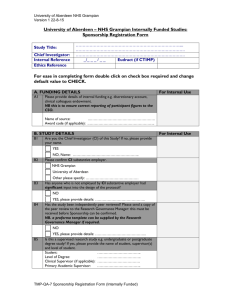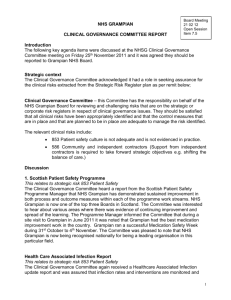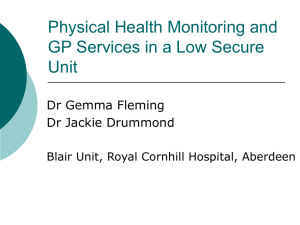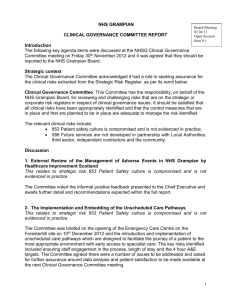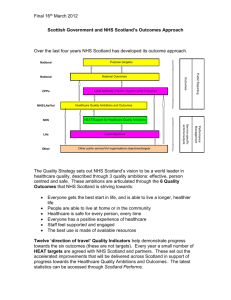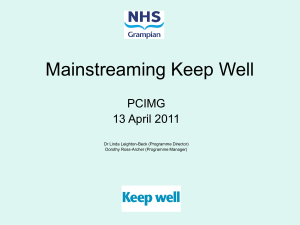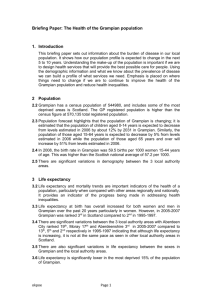Innovation for Health and Healthcare
advertisement
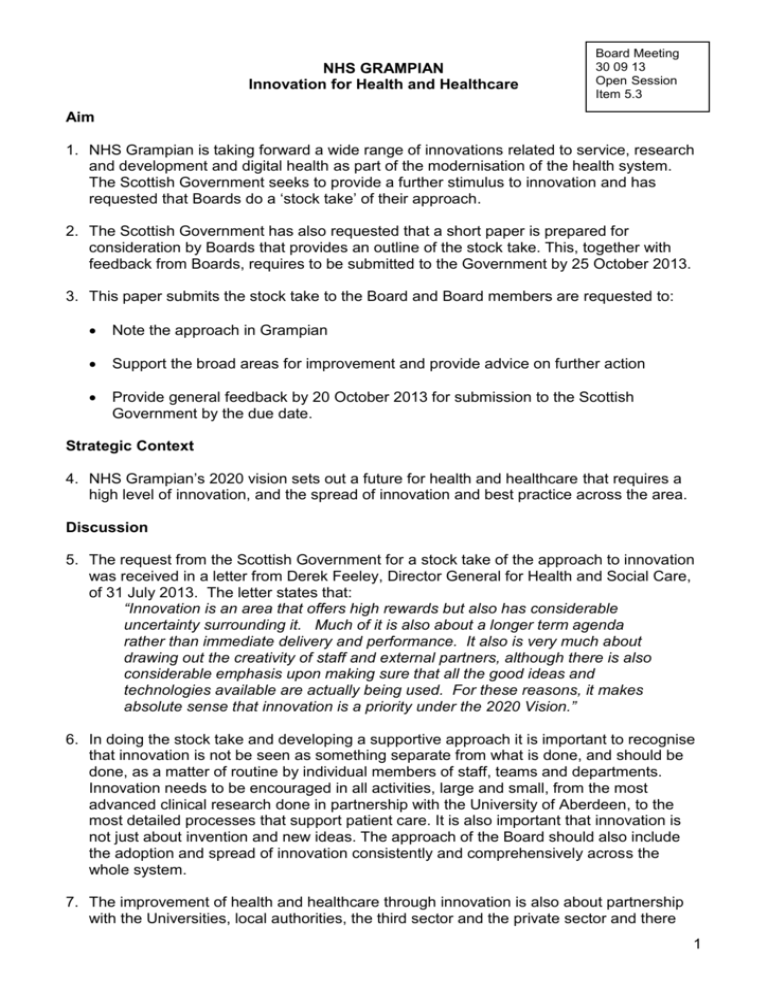
NHS GRAMPIAN Innovation for Health and Healthcare Board Meeting 30 09 13 Open Session Item 5.3 Aim 1. NHS Grampian is taking forward a wide range of innovations related to service, research and development and digital health as part of the modernisation of the health system. The Scottish Government seeks to provide a further stimulus to innovation and has requested that Boards do a ‘stock take’ of their approach. 2. The Scottish Government has also requested that a short paper is prepared for consideration by Boards that provides an outline of the stock take. This, together with feedback from Boards, requires to be submitted to the Government by 25 October 2013. 3. This paper submits the stock take to the Board and Board members are requested to: Note the approach in Grampian Support the broad areas for improvement and provide advice on further action Provide general feedback by 20 October 2013 for submission to the Scottish Government by the due date. Strategic Context 4. NHS Grampian’s 2020 vision sets out a future for health and healthcare that requires a high level of innovation, and the spread of innovation and best practice across the area. Discussion 5. The request from the Scottish Government for a stock take of the approach to innovation was received in a letter from Derek Feeley, Director General for Health and Social Care, of 31 July 2013. The letter states that: “Innovation is an area that offers high rewards but also has considerable uncertainty surrounding it. Much of it is also about a longer term agenda rather than immediate delivery and performance. It also is very much about drawing out the creativity of staff and external partners, although there is also considerable emphasis upon making sure that all the good ideas and technologies available are actually being used. For these reasons, it makes absolute sense that innovation is a priority under the 2020 Vision.” 6. In doing the stock take and developing a supportive approach it is important to recognise that innovation is not be seen as something separate from what is done, and should be done, as a matter of routine by individual members of staff, teams and departments. Innovation needs to be encouraged in all activities, large and small, from the most advanced clinical research done in partnership with the University of Aberdeen, to the most detailed processes that support patient care. It is also important that innovation is not just about invention and new ideas. The approach of the Board should also include the adoption and spread of innovation consistently and comprehensively across the whole system. 7. The improvement of health and healthcare through innovation is also about partnership with the Universities, local authorities, the third sector and the private sector and there 1 needs to be a common spirit of innovation which supports the person centred approach. NHS Grampian has a good track record of partnership in innovation from the use of the digital health experience lab involving the public to develop the No Delays concept, to the testing of new approaches to community care in partnership with local authorities. 8. Government policy is also aimed at making strong links between innovation and the development of the Scottish economy as indicated in the publication “Health and Wealth in Scotland: A Statement of Intent for Innovation in Health”. This seeks the involvement of the private sector as partners in innovations as a key feature of economic development. 9. The annex to this paper provides an overview of NHS Grampian’s approach to innovation and related activities through responses to the specific questions set out in D Feeley’s letter of 31 July. Work will continue to be done on the stock take prior to submission to the Scottish Government and a more detailed submission will be included in the forward programme for Board meetings and seminars. Risks 10. This submission relates to strategic risk 851: Delivery strategies to meet the future health needs of the population i.e. the encouragement and support of innovation will improve health and healthcare delivery to meet the needs of the population. Conclusion 11. NHS Grampian has a good track record in supporting innovation and spreading innovation. The stock take provides a useful overview a number of areas for improvement have emerged. Work will continue on the stock take and the embedding an innovative spirit in all activities. 12. A more detailed session on innovation linked to specific health and service improvement will be included in the forward programme for the Board meetings and seminars in the coming months. Recommendation 13. It is recommended that the Board: 1. Notes the approach in Grampian 2. Supports proposals for improvement and provide advice on further action 3. Provides general feedback by 20 October 2013 for submission to the Scottish Government by the due date. Executive Lead: Graeme Smith, Director of Modernisation Lead Manager: Andrew Fowlie: Lead General Manager for Digital Health September 2013 2 Annex 1 Summary Stock Take 1. What are seen as current areas of strength in innovation for the Board in terms of invention, adoption and spread? NHS Grampian has a strong focus on innovation through the development of the modernisation programme in partnership with the universities, local authorities, third sector and private sector. Key actions and areas of innovation are summarised below: The Modernisation Directorate was established in 2012 to provide a focus for innovation linked to service improvement, strategic planning, organisational development and the delivery of the 2020 vision. The clinical decision support concept has been developed as part of the unscheduled care programme and the first pre-hospital clinical decision support service in Scotland started operation in September 2013. An innovative approach has been taken to the workforce constraints in unscheduled care with the development of an integrated approach involving the GMED out of hours service and primary care practices. This approach is under development and will include the joint appointment of staff across daytime and out of hours services to ensure workforce sustainability. Workforce innovation is a strength with creative approaches to challenges including the plan to integrate advance clinical practitioners across daytime and out of hours practice; and Physicians Assistants – a new type of professional developed in partnership with the University of Aberdeen which will deliver treatment in both unscheduled and planned care settings (first cohort available October 2013) A range of planned care innovations including video consultations and remote monitoring with on line interactions are being rolled out in 2013/14 for diabetes, respiratory care, dementia post diagnostic support and maternal/child care. Grampian is connected internationally and hosted a World Health Organisation Conference on Digital Health with the United Nations and the Scottish Government in 2012. An active network of projects and exchange with key Asian, African and North American stakeholders is in place. Grampian has a strong European portfolio having participated in four FP7 programmes in 2013 with a project related to medical workforce securing funding in collaboration with Aberdeen University. NHS Grampian works with other health and social care providers to learn and innovate in partnership. Formal partnerships are in place with Lothian, Forth Valley, Western Isles and Highland Boards as well as with English Trusts (Liverpool and Rotherham). Remote and rural medicine and health care is a key strength for NHS Grampian e.g. working closely with north of Scotland partners on issues as diverse as stroke 3 telemedicine, the Dot Rural TSB funded Research Unit and providing remote health care services to the North Sea Oil and Gas industry. Strong portfolio of innovation programmes including decision support, two DALLAS (Developing Assisted Living and Lifestyles at Scale) projects, Stratified Medicine Innovation Centre membership and internal digital redesign in areas such as respiratory care. There are innovative approaches to the solution of facilities challenges e.g. the development of the Maud Resource Centre, Suttie Centre and Dental School in partnership with the University of Aberdeen, University of Aberdeen Dental School and Hospital, and support for the funding approach to develop a health facility in Insch. The Board provides a visible and vibrant platform for industry offering test bedding, endorsement, clinical opinion, design advice, architecture development, market intelligence and a range of other high value interactions. Examples include Briadlock Ltd working with surgeons to develop a new catheter; advice to genomic companies on deployment ideas for new tests; and multi-site research access for companies at earlier stages of development – Grampian manages multi-site trial access in Scotland. Grampian hosts a range of pre-procurement partnership arrangements with companies beyond the facilitation of research e.g. from single company collaborations such as mobile platform development for clinical decision support with Samsung to multi-company collaborations through the UK Scientific Research Base Interventions process. Further examples include App development with Umotif Ltd via the diabetes MCN; and trialling Speck Ltd devices for home based cardiovascular monitoring. Large private sector organisations such as ATOS have located to Grampian to work with health and care innovators. ATOS opened their second Innovation Centre in Europe in the NHS Grampian area this year with a capacity for 200 staff but with access to their 60,000 employees and a varied R&D network. A range of Small/Medium Enterprises (SMEs) are also working in the health space including digital companies such as Acunostics (Forres) which is developing new diabetes blood sugar test technologies that replace the need for test strips, and Cytosystems (Aberdeen) developing a medical device that tests urine for signs of urological cancers. NHS Grampian hosts and supports the Digital Health Institute in Forres in partnership with the Glasgow School of Art, stakeholder universities and industry partners. A range of Grampian clinical services have worked with the Living Lab facility in Forres to redesign clinical pathways with academic/industrial and public support to try out new ideas using simulation e.g. the melanoma pathway and crones disease pathway. Innovative work done by the Older Peoples Collaborative in partnership with NHS Tayside has produced good results in reducing falls and increasing the proportion of patients being screened for cognitive function. Grampian has good experience in adopting new models of care such as the community based diabetes care, localised point of care testing and the emergency eye health network. 4 National recognition of the patient safety and improvement approaches which encourage innovation at all levels in relation to direct patient care. Proposal Given the range of innovative work that is underway it is proposed that a directory of innovations is prepared and maintained to ensure there is an understanding of the activity and to facilitate networking between innovators 2. Are there any gaps in skills, knowledge and experience that limit the ability to create, develop, design and apply different ways of delivering services, and how could collective working across Boards or in partnership with others help to address these? There are limited gaps in skills, knowledge and experience – the main gaps are related to the capacity of the organisation to support innovation. The aim will be for the Modernisation Directorate to identify those who have the necessary skills/experience to stimulate and sustain innovative approaches and use this to develop capacity within services and departments across the organisation. The skills, knowledge and competence gaps that do exist are filled through collaborations with partners in educational institutions, other Boards, industry etc. There is a need to accelerate integration with national infrastructure for innovation e.g. the Glasgow University Medical Sensor Innovation Centre capacity and capability is as yet an unknown. Many innovations and innovative practices are not adopted because they are not known – a national innovation network should be established which would make it easy to share ideas and information. Proposal There is a requirement for a Clinical Research Facility at Aberdeen Royal Infirmary to attract research and secure the position of NHS Grampian as a high quality research and development location. This should be included in the reconfiguration project for Aberdeen Royal Infirmary. 3. What are the issues and services that the Board regards would most benefit from a greater emphasis on innovation? A focused approach on developments in digital health building on existing innovations to spread application e.g. No Delays, clinical decision support New approaches to the delivery of primary/community care and collaboration with communities to encourage greater self care and self reliance – the Alaska model of primary care is being investigated and a number of lead clinicians are motivated to develop a new approach. Encouraging whole service innovation with the aim of applying technological and service solutions to maintaining people in their own homes e.g. in respiratory care 5 New business models that engage industry in innovation on an ongoing basis. As technology changes there is a need for new procurement processes and business models that share risk with commercial partners in a way that increases focus on innovative solutions e.g. payment structures partly connected to outcomes such as reduced admissions, outpatient appointments etc. 4. How are staff supported to develop innovative ideas and - if they do - what arrangements exist to support adoption (and how this should be developed)? Grampian has a range of forums that bring health and care professionals together to share new ideas. Examples of adoption and spread include primary/social care cluster working to provide local solutions for populations through to the rapid training and deployment of Dental Therapists to meet oral health demand. Grampian has a recognition scheme for staff i.e. the GRAFTA’s. Grampian facilitates training and education for innovation including secondments, in house development plans and external training. Grampian will open its second fully accredited NES standard training unit this year. Grampian clinicians are supported to innovate at work and where possible capture and exploit new intellectual property rights. Two current projects are supported through national innovation structures i.e. No Delays (software as a service) via the Digital Health Institute; and Softcell (new medical device to assess tissue changes) via the Health Innovation Partnership for Med Tech. Proposal In addition to the above it is proposed that the NHS Grampian organisational development plan is reviewed to ensure that there is a focus on creating the right conditions for staff to be supported in the development of innovations. The standing financial instructions related to the rewards for staff who develop innovations that are subsequently commercialised will be reviewed to ensure that they are appropriate and provide the right balance between individual and organisational reward. 5. What is currently in place to bring staff together to work on a collective basis to share the best ideas and practice to develop innovative solutions (and how this should be developed)? Primary care is organised on the basis of clusters bringing together practices on an area/community basis – this will form the basis of integrated working at a local level and provide a clear interface with acute services for the redesign of pathways. Managed Clinical Networks bring clinical service and public stakeholders together to coordinate health and healthcare across Grampian and focus on innovative ways to deliver care. 6 Service improvement and patient safety projects have broad staff involvement with the focus on developing innovative ways to deliver safe services supported by improvement methodologies. The Digital Health Institute in Grampian provides a focus and support facilities for staff and the public to test and develop ideas. The 2020 vision approach encourages staff to come together to visualise how there service/department will be in the medium to long term and stimulates an improvement and innovative approach to change. Grampian has been successful in securing nine Scottish Patient Safety (SPSP) Fellowships. The staff invplved have been supported to take forwards projects that have demonstrated innovation e.g. heart failure education toolkit won the National Nursing Times Award in 2012. The SPSP programme has a network of staff involvement which feeds into an Executive Leadership group chaired by the Chief Executive and Director of Nursing and Quality. The annual Quality and Safety in Healthcare event has a strong focus on innovation related to patient care. This event is jointly organised by NHS Grampian, University of Aberdeen, and Robert Gordon University. The May 2013 event was oversubscribed with 237 delegates registered and 99% “highly recommending/recommending” the event. There has been investment to support innovation in the form of two Life Science Centres (Suttie Centre in Aberdeen and the Alexander Graham Bell Centre in Elgin), two new theatres at Aberdeen Royal Infirmary to enable robotic surgery (first in Scotland); digital health provision for decision support and No Delays Proposal As a means of further strengthening and supporting staff it is proposed that an innovation network is created to actively share and promote innovative approaches across the area and to link with innovators in other Boards, the universities, the public sector and industry. 6. What is currently in place to give staff time and recognition in their job plan/objectives to undertake work on innovation (and how this might be developed)? Secondments and protected time are provided to work on specific projects and innovations e.g. staff are seconded to the Modernisation Directorate fixed periods to build capacity, spread change and develop innovations. Grampian has a comprehensive objective setting process and consideration will be given to the inclusion of innovation as a major theme. 7 Proposal Staff do spend time on innovations in the normal course of their work. However, there is a need to review whether specific protected time is required to support innovation and R&D. This will be considered with the partnership forum and the universities. 7. What would the Board regard as a success from pursuing a greater emphasis on innovation? (This might include generic measures and relate to processes such as pace of adoption.) Quality and efficiency gains including the reduction of medication waste, DNA’s and errors. Increased care at home or in communities e.g. through the application of No Delays, clinical decision support, telehealth and telecare technology. Speedier adoption of new mobile technologies such as blood pressure devices in the community or lower cost ECG machines in general practice. Improved spread of innovations and innovative pathways across all services. Better patient outcomes from initiatives such as robotic surgery and personalised prescribing. Income from commercialisation and industrial/academic grants which can be applied to further strengthen the approach to innovation and improvement. 8. Are there any existing national or local change programmes that give suggestions about how to achieve success with being more innovative? All national programmes highlight areas for adoption and spread of good practice. As part of projects such as the Change Plan for Older People there is a focus on community based innovation in the form of co-production through to remote access to health care settings e.g. video visits to hospitals instead of in person visits. The Grampian approach to clinical decision support and No Delays as drivers of change are being considered as models for adoption nationally. 8
